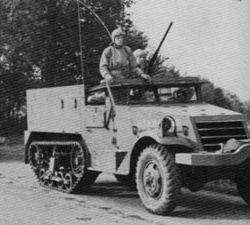This article includes a list of general references, but it lacks sufficient corresponding inline citations. (January 2013) |
| M2 half-track | |
|---|---|
 US | |
| Type | Half-track artillery tractor/reconnaissance vehicle |
| Place of origin | United States |
| Service history | |
| Used by | See Former operators |
| Wars | World War II First Indochina War Cambodian Civil War Nicaraguan Revolution |
| Production history | |
| Designer | Firestone Defense Division |
| Specifications | |
| Mass | 9 metric tons |
| Length | 5.96 m (19 ft 7 in) |
| Width | 2.2 m (7 ft 3 in) |
| Height | 2.26 m (7 ft 5 in) |
| Crew | 2 |
| Passengers | 7 |
| Armor | 6–12 mm |
Main armament | 0.5 inch M2 Browning heavy machine gun |
Secondary armament | 14 mines, 10 hand grenades[1] |
| Engine | 386 cu in (6.33 L) White 160AX inline six[1] 148 hp (110 kW; 150 PS)[1] |
| Suspension | Wheeled front axle, rear track |
Operational range | 220 mi (350 km) (average)[1] |
| Maximum speed | 45 mph (72 km/h)[1] |
The M2 half-track car was an armored half-track produced by the United States during World War II. Its design drew upon half-tracks imported from France in the 1930s, employing standard components supplied by U.S. truck manufacturers to speed production and reduce costs. The concept was designed, and the pilot models manufactured by the Firestone Tire and Rubber Company (before the prototype was officially labeled M2.)[2] Production by the White Motor Company began in 1940 and was expanded to include Autocar.
The M2 was initially intended for use as an artillery tractor, but also found use with reconnaissance units. International Harvester Company built the M9 half-track, a variant of their M5 half track, to fulfill the same purpose. It saw wide use in World War II, chiefly by the United States, but also by its allies. A few legacy units were used in the Nicaraguan Revolution.